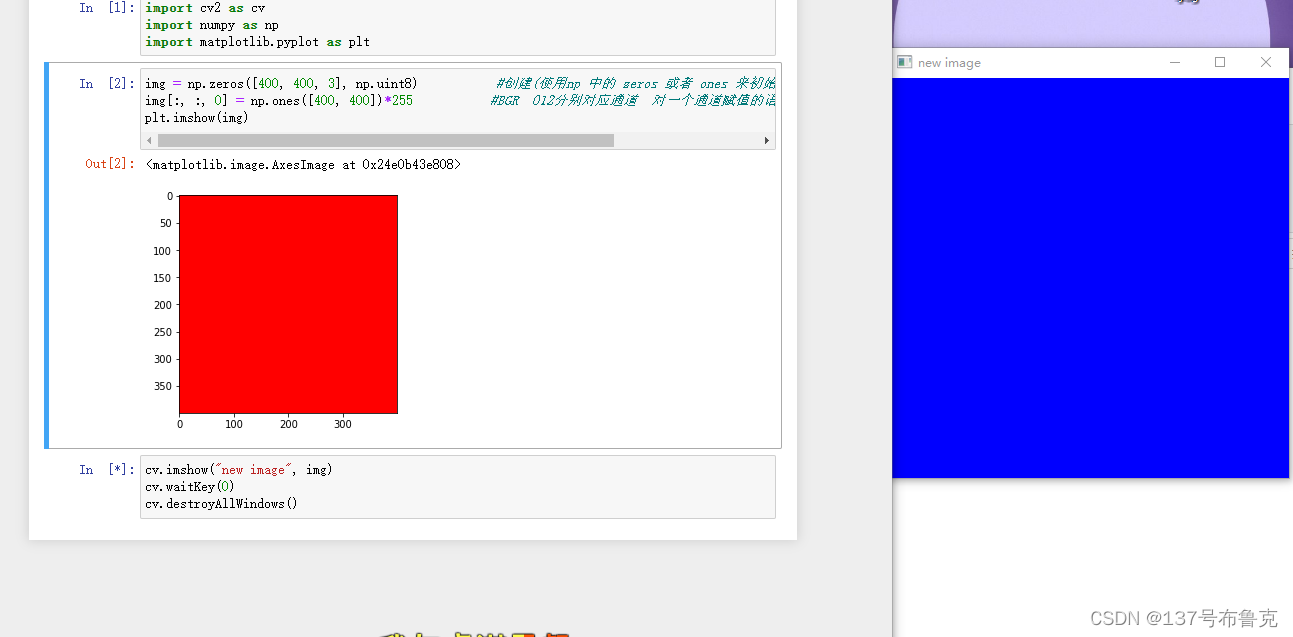一、
image.shape 图片形状 为 [h, w, c] 高, 宽, 通道
img.shape图片取反思路:遍历图片,每一个像素都被255减,代码如下
image = cv.imread('img.jpg') #读取图片
print(image.shape) #查看图片形状
hight = image.shape[0] #提取图片的高度
width = image.shape[1] #提取图片的宽度
channels = image.shape[2] #提取图片的通道数量
print("height : %s,width : %s,channels : %s"%(hight, width, channels)) # %s打印各个变量
for row in range(hight): #循环每个像素,像素很多,CPU反应慢"""
for col in range(width):
for c in range(channels):
pv = image[row, col, c] #使用PV保存
image[row, col, c] = 255-pv #取反
cv.imshow("pixels_demo", image) #显示这是一个很好的思路,但是这么做的话,取反几千张图片的时候CPU反应会很慢,所有opencv提供了一个取反的API,直接把图片放入即可,也可以添加mask(这里不举例了)
dst = cv.bitwise_not(image)
cv.imshow("pixels_demo", dst)二、使用np创建图片,代码如下:
img = np.zeros([400, 400, 3], np.uint8) #创建高400 宽400 3通道,数据类型为 np.uint8图片
img[:, :, 0] = np.ones([400, 400])*255 #给高400,宽400 通道0赋值255
cv.imshow("new image", img) #显示注意:在cv中三通道排序为BGR,在plt中为RGB,请看演示(红色为plt所画的,蓝色为cv所显示的)
?
三、cv定时器:
cv.getTickCount()
t1 = cv.getTickCount() #获取到目前为止的cpu时钟的总数,相当于程序运行到这的时间
creat_image()
t2 = cv.getTickCount() #t2程序运行到这的时间
time = (t2-t1)/cv.getTickFrequency()四、全部代码
#创建空白图像,定义数组,图片取反
import cv2 as cv
import numpy as np #numpy为科学计数,数组,矩阵,计算等专用库
#定义宽高以及通道数目函数
def access_pixels(image):
print(image.shape)
hight = image.shape[0]
width = image.shape[1]
channels = image.shape[2]
print("height : %s,width : %s,channels : %s"%(hight, width, channels)) # %s打印变量
for row in range(hight): #循环每个像素,像素很多,CPU反应慢"""
for col in range(width):
for c in range(channels):
pv = image[row, col, c]
image[row, col, c] = 255-pv #取反
cv.imshow("pixels_demo", image)
def inverse(image): #此函数功能和access_pixels一样,都是取反
dst = cv.bitwise_not(image)
cv.imshow("pixels_demo", dst)
def creat_image():
"""""
img = np.zeros([400, 400, 3], np.uint8) #创建(使用np 中的 zeros 或者 ones 来初始化)一张图片(数组) 多通道
img[:, :, 0] = np.ones([400, 400])*255 #BGR 012分别对应通道 对一个通道赋值的语法
cv.imshow("new image", img)
img = np.zeros([400, 400, 1], np.uint8) #创建单通道图片
img[:, :, 0] = np.ones([400, 400])*50 #只能是通道0,50这个数值可修改
cv.imshow("new image", img)
#或者上面三句改为img = np.ones([400, 400, 1], np.uint8)
#img = img * 50
cv.imwrite("D:/newpiture.png", img)
"""""
m3 = np.array([[1, 2, 3], [4, 5, 6]], np.uint8) #array定义了2行3列数组,可以用fill填充 不过最好使用ones与zeros定义数组
m3.fill(9)
print(m3)
m1 = np.ones ([3, 3], np.float32) #定义浮点型数组, 可定多种数据类型 np.ones[宽, 高, 通道]
m1.fill(128.388) #fill 为填充给数组数据
print(m1)
m2 = m1.reshape([1, 9])
print(m2)
img = cv.imread('1.jpg')
cv.imshow('img', img)
t1 = cv.getTickCount() #获取到目前为止的cpu时钟的总数,相当于程序运行到这的时间
creat_image()
t2 = cv.getTickCount() #t2程序运行到这的时间
time = (t2-t1)/cv.getTickFrequency()
print("time : %s ms"%(time*1000))
cv.waitKey(0)
cv.destroyAllWindows()